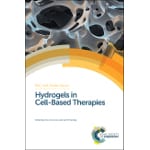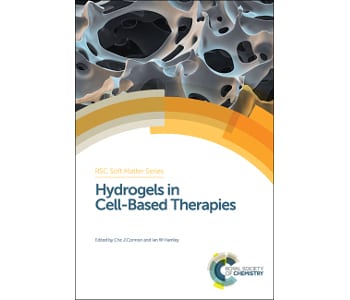
Copyright © 2014 Royal Society of Chemistry.
Hydrogels in Cell-Based Therapies
Edited by Che J. Connon and Ian W. Hamley
Hardcover
ISBN: 978-1-84973-798-2
238 pages
$155
Click here for more information
Reviewed by Professor Alexander Zelikin, Aarhus University
“Hydrogels in Cell-Based Therapies” edited by Che J. Connon and Ian W. Hamley consists of 9 chapters devoted to the diverse aspects of biomaterials science with a focus on hydrogels. The authors in this book are easily recognized as some of the who’s who in this area of biomedical materials science, with long standing reputations as leaders in the field. The book provides a broad and well-balanced presentation on hydrogel biomaterials and covers assembly and properties of materials based on synthetic polymers, natural polymers, recombinant proteins, and small-molecule gelators. Discussion topics include materials assembly, characterization, initial evaluation in cell culture, in vivo experimentation, and translational aspects of science. The book is a good start for those who want to enter the field of hydrogel biomaterials or need a quick reference on the subject but also contains advanced knowledge such that even the experts will likely find something new for themselves.
Transports phenomena in hydrogel biomaterials are discussed by M. Parlatto and W. Murphy and present the barriers of substrate diffusion, both phenomenologically and through mathematical description of the processes. Spatio-temporal control over drug delivery as well as diffusion of the nutrients and metabolites into and out of the hydrogel matrices is of the highest importance for practical implementation of these biomaterials in all areas of biotechnology and biomedicine.
Biocompatibility is one of the most important aspects to be considered in the context of engineering of biomaterials. This topic is particularly important when dealing with small molecule gelators – with enhanced rates of cell entry as compared to macromolecules. This subject is discussed by Xu et al (Brandeis University, USA) from the structure-function perspective and includes the data of in vivo acceptance of these hydrogels.
Engineering hydrogels through successful engineering of constituting proteins is discussed as an approach to create environment for the cells based on a good understanding of the interaction between the cells and extracellular matrix. Motivation for this, nature of the interactions, techniques in the domain-level engineering, successes in protein-engineered cell delivery systems, and translational aspects of this technology are presented for an overview of this strategy to biomaterials design by Heilshorn et al (Stanford University, USA).
Instructive role of biomaterials in tissue engineering is a hot topic in the biomaterials science. Communication to adhering cells can proceed with the use of chemical stimuli, a notion well understood and used for decades. Further to this, it was recently discovered and is being rapidly investigated that hydrogel biomaterials mimic the tissue and at the same time send instructive stimuli to the cells – using matrix elasticity, i.e. softness. These opportunities are discussed in two chapters of this book (Connon et al, University of Reading, UK and Yang et al, Trinity College Dublin) and are discussed from a number of perspectives, from aspects of materials engineering and characterization of biomaterials per their elasticity to translational considerations and medical relevance of these biomedical findings.
Encapsulation of probiotic bacteria is important for nutritional science and to improve the shelf life of probiotic foods. One of the most successful approaches to achieve this is based on immobilization of bacteria within alginate hydrogels. Encapsulation techniques are discussed by Cook et al (Reading, UK) starting with the considerations pertaining to the chemistry of alginates, production of alginate hydrogels, and to demonstration of efficacy of the alginate microcapsules for encapsulation of probiotics. The chapter also includes an anecdotal account of the origin of the field which dates back to 19th century and includes scientists awarded one of the early Nobel prizes.
The use of alginate hydrogels for encapsulation of mammalian cells is a complimentary chapter (Connon et al, Reading UK) and presents successes of these biomaterials in encapsulating stem cells or differentiated cells for cardiac tissue repair, neovascularization, construction of neural prosthetics, and other areas of biomedical research. The chapter includes a broad table of preclinical studies of therapeutic cell delivery using alginate hydrogels.
Enzyme responsive hydrogels are presented by Ulijn et al (University of Strathclyde, Glasgow). This subject covers both degradation of the biomaterial by an enzyme through the scission of chains or junction knots of the matrix as well as hydrogelation as a result of an enzymatic process. Of these, the latter is the main focus of this chapter and is discussed in detail. Biocatalytic hydrogelation is a relatively new but increasingly popular topic in biomedical research. The main advantage point for this approach is that biomaterials assembly can proceed at constant physiological conditions. Majority of studies make use of peptide hydrogelators and enzyme-catalyzed change in the hydrophiolicity-hydrophobilcity balance in the molecules. The aspects of biomedical engineering around these materials, current applications, and biomedical relevance of these studies are well overviewed and presented for a broad audience.
The book is concluded by a chapter by Skardal (Wake Forest School of Medicine, US) on ECM-like hydrogels and specifically focused on applications of these biomaterials in regenerative medicine. Much of the subjects discussed elsewhere in this book come together in this chapter in the context of translational research and practical implementation of biomaterials designs in clinic.

















